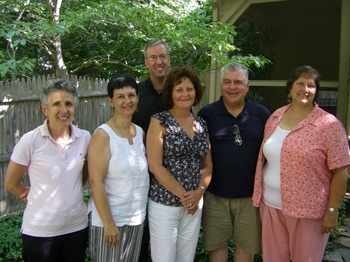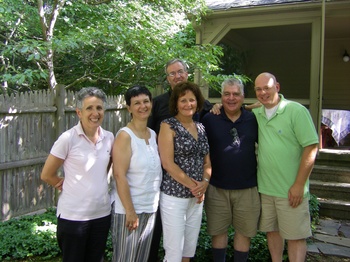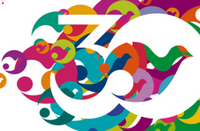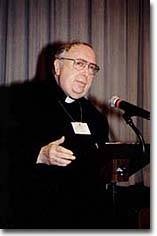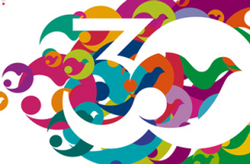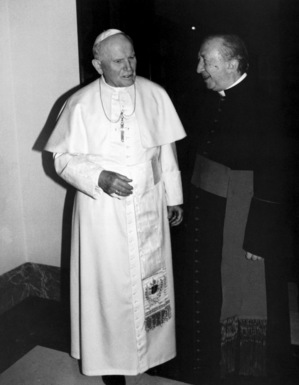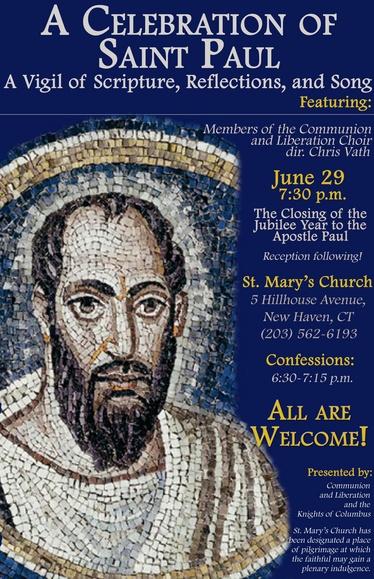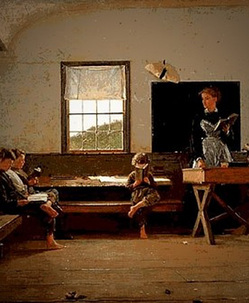Category: Communion & Liberation
Rimini Meeting 2009: follow it NOW
Hey!!! Follow
the progress of the 30th Rimini Meeting working under the theme of Knowledge is always an event.
Particularly
fascinating to me are the photos of the events which speak a 1000 words.
Remember to keep the Meeting in your daily prayer to the Holy Spirt: It’s
an opportunity to meet Christ!
Given the hard and beautiful of work that has
transpired over three decades in putting the Meeting together, a 2-part video
presentation takes us through the highlights. See 30 years of the Rimini
Meeting: A Review —part 1
and part 2.
If
you care to watch some of the Meeting on TV
if you can manage Italian and Spanish.
Take a look at what’s on deck for the
program and notice the variety of speakers… the program can
be found here which I recommend your perusing.
Pope Benedict XVI
said at the Angelus: “Today the 30th edition of the ‘Meeting for
Friendship Among Peoples’ has opened in Rimini, [Italy], taking as its
title ‘Knowledge Is Always an Event.’ In addressing a cordial greeting to those
who are taking part in this significant gathering, I hope that it will be a
propitious occasion for understanding that ‘[k]nowing is not simply a material
act, since … [i]n all knowledge and in every act of love the human soul
experiences something ‘over and above,’ which seems very much like a gift that
we receive, or a height to which we are raised’ (Caritas in Veritate, No.
77).”
How Communion and Liberation moved me: Fr Meinrad Miller reflects
Earlier today I was speaking with my friend, Father Meinrad Miller, a Benedictine monk of Saint Benedict’s Abbey (Atchison, KS) and he told me he wrote this article for the local Catholic diocesan newspaper on his experience with the movement we both closely follow, Communion and Liberation. What Father Meinrad says in his article is applicable to all of us. It’s reprinted here for education of us all. Let me know what you think of it.
Seven years ago
this fall an event happened here at Benedictine College that would change my
life. My college roommate, B.J. Adamson, had told me over the years about a
Catholic movement he had discovered back in Denver: Communion and Liberation
(CL). B.J. would often tell me about the method of the movement’s dynamic
founder, Monsignor Luigi Giussani (October 15, 1922-February 22, 2005), and of
a friend of the movement here in the United States Monsignor Lorenzo Albacete.
Cardinal Stafford, then the Archbishop of Denver, had spoken highly of CL.
In
September 2002 we hosted a presentation here at Benedictine College on one of
Giussani’s key books, The Religious Sense. The presentation included talks by Monsignor
Lorenzo Albacete, a physicist,
theologian and good personal friend of Pope John Paul II; Major David
Jones, an army officer who had been attracted to the Catholic faith after
watching a show on EWTN with Raymond Arroyo in which Monsignor Albacete was
interviewed about Monsignor Giussani; Dr. Eduardo Echeverria, currently a
philosopher at Sacred Heart Seminary in Detroit; and Mike Eppler, the Youth
Minister for the Evansville, Indiana Diocese.
What appealed to me about this
first presentation was that everything said that evening deepened my own appreciation
of being a Benedictine monk. Giussani’s method affirms that the encounter with
Christ is possible to all people. Over the coming years we would have further
book presentations here at the college on the writings of Monsignor Giussani.
Each time I would grow in my fascination for the message of Christ as relevant
and part of life today. It was only later that I learned that St. Benedict was
the patron saint of the movement. At one time Monsignor Giussani had written to
some Benedictine monks near Milan, Italy. In part he said: Christ present! The
Christian announcement is that God became one of us and is present here, and
gathers us together into one body, and through this unity, His presence is made
perceivable. This is the heart of the Benedictine message of the earliest
times. Well, this also defines the entire message of our Movement.
Perhaps
Monsignor Giussani’s fascination with St. Benedict began as a young seminarian
for the Archdiocese of Milan. The Archbishop during Monsignor Giussani’s
seminary training was Blessed Ildephonse Schuster, O.S.B., the saintly
Benedictine. The same year that Blessed Ildephonse Schuster died, 1954, would
mark a major change in the life of Giussani as well.
While riding on a train
for vacation in 1954, Giussani noticed from the conversation of the youth on
the train that there was little interest in Christianity. Much of the
discussion focused on the ideologies of the day, including Marxism. Giussani
asked the new Archbishop’s permission to leave his work as a seminary professor
and begin to teach high school students.
The conversion on the train reminded
me of Blessed Mother Teresa’s own conversion. This past year I gave a seminar
to the Missionaries of Charity in Washington, D.C. As I was reading about
Blessed Mother Teresa I could not help but notice a similarity with Monsignor
Giussani. Mother Teresa was also on a train on September 10, 1946, going for
her yearly retreat in the mountains of India. It was on the train that she had
a mystical experience in which she would experience the great thirst God has
for souls. Not just for water but for men and women to experience the real thirst
of God’s love for them.
Eight years after Blessed Mother Teresa’s experience on
the train in 1946, Monsignor Giussani would have his experience on the train in
1954. Years later he would also reveal the depth of this conviction when, in
front of Pope John Paul II and hundreds of thousands of people gathered at St.
Peter’s square on Pentecost Sunday, 1998, he would say: Existence expresses
itself, as ultimate ideal, in begging. The real protagonist of history is the
beggar: Christ who begs for man’s heart, and man’s heart that begs for Christ.
Whether
one looks at our humanity in terms of Christ thirsting for us in the words of
Blessed Mother Teresa, or Christ begging for man’s heart, in the words of
Monsignor Giussani, the same dynamic is present. Christ desires us to encounter
Him as a present reality, not just a distant myth.
On September 10, 2004,
Cardinal Ratzinger, the future Pope Benedict XVI, would describe his own
meeting with Monsignor Giussani in the early 1970s, and Communion and
Liberation:
It was an interesting discovery for me; I had never heard of this
group (Communion and Liberation) until that moment, and I saw young people full
of fervor for the faith, quite far from a sclerotic and weary Catholicism, and
without the mentality of “protest”-which considers all that was there before
the Council as totally superseded-but a faith that was fresh, profound, open
and with the joy of being believers, of having found Jesus Christ and His
Church. There, I understood that there was a new start, there was really a
renewed faith that opens doors to the future.
This same experience is relived
today by groups in the region in Kansas City, Benedictine College, KU, and
Wichita that meet weekly to follow the method of Monsignor Luigi Giussani.
Father
Meinrad Miller, O.S.B. is the Subprior of Saint Benedict’s Abbey, and Chaplain of
Benedictine College in Atchison, KS
This article was recently published in The Catholic key, the Catholic newspaper of the Diocese of Kansas City-St Joseph, MO.
Rimini Meeting 2009 get the diplomats thumbs up
The Meeting for Friendship Among the Peoples is about start in Rimini, Italy. Since 1980 there has been a meeting of friends and interested peoples gathered together to understand the various points of contact in knowledge, faith, culture and human experience. There’s been an average of 700,000 people attending this week long event. The Rimini Meeting is influenced by the thought of the founder of Communion and Liberation, Msgr. Luigi Giussani.
The cultural and interreligious dialogue at the 2009 Rimini Meeting will be happening 23-29 August 2009. The theme for this year’s meeting is “Knowledge is Always an Event.”
Watch the video clip on the diplomats’ preview of the meeting.
The Crossroad Cultural Center did a Washington, DC presentation on this year’s Meeting. See the transcript of the event.
Various pieces of info on the work of the meeting:
+ The Rimini Meeting: 30 years of dialogue
+ The exhibitions at the meeting
Love for Christ reawakened thru Luigi Giussani, Benedict XVI recalls
 My first thought goes — it’s obvious — to your
My first thought goes — it’s obvious — to your
founder Monsignor Luigi Giussani, to whom many memories tie me, since he had
become a true friend to me. Our last meeting, as Father Carrón mentioned, took
place in Milan Cathedral two years ago, when our beloved Pope John Paul II sent
me to preside at his solemn funeral.
Church a movement — yours — that would witness the beauty of being Christians
in an epoch in which the opinion was spreading that Christianity was something
tiresome and oppressive to live. Father Giussani, then, set himself to reawaken
in the youth the love for Christ, the way, the truth and the life, repeating
that only he is the road toward the realization of the deepest desires of man’s
heart; and that Christ saves us not despite our humanity, but through it.
Benedict XVI, address to Communion and Liberation, March 25, 2007
Lorenzo Albacete recounts meeting Luigi Giussani
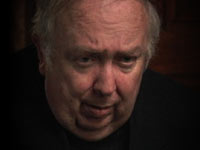 When I first met Msgr. Giussani 16 years ago, I had no
When I first met Msgr. Giussani 16 years ago, I had no
idea what we would talk about. I flew up from Rome to Milan to have lunch with
“Don Gius” and a mutual friend who had arranged the meeting. I thought our
friend would guide the conversation, but the day before the meeting I learned
that he would not be there. It would just be a lunch meeting between Giussani
and myself. On the flight to Milan, I browsed through a book by Giussani that I
had picked up in order to have it autographed (L’Avvenimento Cristiano, The
Christian Event), and because our friend had told me it would help me understand
what Giussani was all about.
interests that we could discuss, I found the following remarks by Fr. Giussani:
“‘The Redeemer of Man, Jesus Christ, is the center of the universe and of
history.’ When I heard John Paul II repeating these words during his first
speech (and the same sentence was literally, my friends can witness to it, the
usual text of our meditation), the emotion I felt reminded me of the
dialectics developed between me and my students at school, and the deep tension
with which we gathered in the name of the Father, the Son, and the Holy
Spirit.” I was amazed because he seemed to be describing the same reaction
I had when, for the first time, I read Pope John Paul II’s first encyclical,
Redemptor Hominis, thirty years ago (March 4, 1979). RH begins with this
affirmation: “The Redeemer of Man, Jesus Christ, is the center of the universe
and of history. To Him go my thoughts and my heart in this solemn moment of the
world that the Church and the whole family in present-day humanity are now
living.”
John Paul II speaking of Communion and Liberation
On 31 March 197 Pope John Paul II said of Communion and
Liberation: “I like this name very much.” Here’s his explanation:
So you too,
young people, beloved young people, have shown, in the very name chosen to
describe your movement “Communion and Liberation” (I must say that I
like this name very much, I like it for many reasons: for a theological reason
and for, I would say, an ecclesiological reason. This name is so closely linked
with the ecclesiology of Vatican II. Then I like it because of the perspective
it opens to us: the personal, interior perspective and the social perspective:
Communion and Liberation. For its topicality, this is the task of the Church
today: a task which is expressed precisely in the name “Communion and
Liberation.” With this name, therefore, you have shown that you are well aware
of the deepest expectations of modern man.
The liberation to which the world
aspires–you have reasoned–is Christ; Christ lives in the Church; man’s true
liberation takes place, therefore, in experience of ecclesial communion; to
build up this communion is, therefore, the essential contribution that
Christians can make to the liberation of all.
Closing the Year of Saint Paul, New Haven, CT … TONIGHT
Spiritual Exercises 2009 available
You can download the 2009 Communion & Liberation Fraternity Spiritual Exercises; the booklet is available in four languages. The print edition will be available with the June issue of Traces magazine. Log on to the CL site here.
What does it mean to be a teacher?
What does it mean
to be a teacher in today’s educational climate? Can an adult be in an educative
relationship with a young person without risk? To be a teacher implies the
offer of a proposal that reaches the heart of the student, but this is only
possible if it is communicated by an energy that originates from the presence
of the educator.
For more info see the website.
